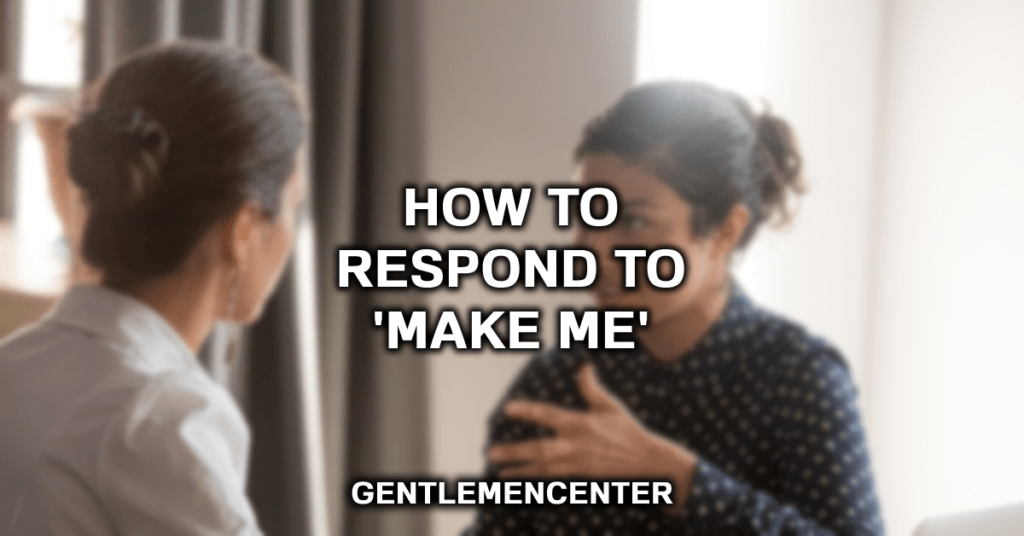Effective communication is a vital skill in personal and professional relationships, ensuring an exchange of ideas, resolving conflicts, and promoting mutual understanding. Sometimes, these interactions present challenges, like coming across a defiant response such as “Make me.”
In the face of this kind of resistance, how should one respond? This article will guide you through the best practices for responding effectively, fostering constructive dialogue, and maintaining respect, all while staying on the path to your objectives.

- How to Respond to “Make Me”
- 26+ Flirty Comebacks to “Make Me”
- Responding to a Flirty Text from a Guy
- Response to “Don’t Tempt Me”
- What Are Some Flirty Words
- Why Is Maintaining Composure Important When Responding To “Make Me”?
- What Is The Significance Of Providing Context When Responding To “Make Me”?
- How Can Empathy Be A Tool When Navigating A Response To “Make Me”?
- How Does Opening A Conversation Help When Someone Says “Make Me”?
- What Does A Non-Defensive Response Look Like And Why Is It Effective?
- How Does Reasserting Your Request Help In Handling A “Make Me” Situation?
- Why Is It Important To Avoid A Power Struggle When Someone Says “Make Me”?
- How Can Maintaining Composure Contribute To Effective Communication?
- What Role Does Empathy Play When Responding To “Make Me”?
- Why Is Providing Context Beneficial When Dealing With Resistance?
- How Does Initiating A Dialogue Help In A “Make Me” Situation?
- Why Is A Non-Defensive Response More Effective?
- What Is The Significance Of Reasserting Your Request When Faced With A “Make Me” Response?
- Why Is Avoiding Power Struggles Essential In Such Interactions?
- Conclusion
How to Respond to “Make Me”
“Make me” is often a phrase that rings with defiance, resistance, or a simple challenge, thrown at us in different situations. It might come from a misbehaving child, a difficult colleague, or anyone asserting their autonomy in a difficult situation.
Knowing how to respond effectively is crucial to keep the conversation productive and to avoid escalating the situation into conflict. Here are a few strategies:
1. Maintain Your Composure
The response “Make me” may provoke an emotional reaction. It’s essential to remain calm, composed, and patient in your response, which will promote a non-confrontational environment and open the space for further dialogue.
2. Non-defensive Response
Replying defensively might escalate the situation. Instead, opt for a non-defensive response like, “I understand where you’re coming from, but let’s talk about why this is important.”
3. Open the Conversation
Use this as an opportunity to start a dialogue. Ask them why they don’t want to do it. This can give you insight into their objections and you can address these accordingly.
4. Empathize
Empathy is key in these situations. Saying something like, “I can understand why you might not want to do this. Is there something we can change to make it work for you?” shows that you respect their perspective.

5. Provide Context
Explaining the reasons behind your request can also help. Giving context and explaining the importance of the task may lead them to reconsider.
6. Reassert Your Request
If all else fails, and the situation allows, reassert your request politely but firmly. Show that you’re serious about your request but avoid falling into the trap of a power struggle.
Remember, the goal is not to ‘win’ the conversation but to maintain a respectful and productive dialogue. It’s about understanding, empathy, and compromise where possible, not brute force or authority.
The art of effective communication is a skill to be practiced and developed over time. The more you engage with it, the more naturally it will come.
26+ Flirty Comebacks to “Make Me”
“I’d love to, but only if you can handle it.” This response playfully acknowledges their challenge while upping the ante, giving you both a chance to enjoy the flirtatious banter.
“Careful, I might take you up on that offer.” This reply not only accepts their challenge but also implies you’re equally willing to engage in some playful banter.
“Why, you need a little extra persuasion?” This is a lightly teasing response that shows your interest while keeping the exchange playful and breezy.
“Oh, I will. But only when you least expect it.” This response is flirtatious and fun, adding an element of suspense and intrigue to the conversation.
“I’m sure you’d like that.” This comeback is playfully presumptuous and adds a spark of flirtatious energy to the conversation.
“I might. But what’s in it for me?” This response adds a playful bargaining element to the flirtation, increasing the fun factor.
“Why make you when I can persuade you?” This implies a charming confidence that can be quite enticing, shifting the interaction from a challenge to a playful negotiation.
“As tempting as that sounds, I’d rather win you over.” This reply infuses a touch of romance into the flirty exchange, suggesting you’d rather charm them than simply making them do something.
“Are you challenging me? Because I like a good challenge.” This is a spirited and playful response that shows you’re not backing down from their flirtatious challenge.
“You sure you can handle what I can dish out?” This response is cheeky and flirtatious, implying that you’re ready to take things up a notch.
“I have a feeling you’d enjoy that more than you’re letting on.” This response is subtly flirtatious, hinting that you understand their playful challenge.
“Tempting, but I think I’ll let you keep dreaming.” This comeback playfully takes the upper hand by leaving them in suspense.

“I could, but then I’d have to charge.” This light-hearted, playful response keeps the banter flowing.
“I might just do that, but only when you least expect it.” This flirty comment adds a touch of mystery and suspense to your conversation.
“With pleasure, but are you ready for the consequences?” This fun reply adds a playful warning that spices up the interaction.
“Your wish is my command, but only for today.” This response is both playful and chivalrous, keeping the banter charming and light-hearted.
“Are you always this challenging? Because I find it intriguing.” This response shows you’re interested and engaged while keeping the exchange fun.
“Are we negotiating? Because I’m liking this deal.” This reply subtly changes the dynamic, shifting the conversation into a playful negotiation.
“Interesting, but I prefer the thrill of the chase.” This response maintains the flirtatious energy while suggesting you’re not going to be easily won over.
“Only if you promise to return the favor.” This is a fun, playful suggestion that keeps the flirty energy balanced and engaging.
“You’re feisty, I like that.” This response compliments them while acknowledging their playful challenge.
“Well, I might just take that as an invitation.” This reply is flirty, playful and suggests you’re ready to play along with their challenge.
“Don’t tempt me, I’m a risk-taker.” This response introduces an element of excitement and adventure into the conversation.
“Only if I can make you laugh first.” This keeps the interaction light-hearted, placing the emphasis on fun and shared humor.
“Only if you say pretty please.” This response is playful and lighthearted, turning the challenge back onto them.
“Consider it done, but don’t say I didn’t warn you.” This response is fun and flirtatious, implying an enjoyable threat.
Remember, the key is to keep the conversation engaging and fun, respecting each other’s boundaries. The flirtatious exchange should be enjoyed by both parties.
Responding to a Flirty Text from a Guy

If a guy sends a flirty text, your response will depend on your level of comfort and interest. If you’re keen on reciprocating, you could reply with something like, “Is someone trying to make me blush? Because it’s working.” This lets him know his text had the desired effect and opens up room for more flirtatious interaction.
Response to “Don’t Tempt Me”
When someone says “don’t tempt me,” they’re typically implying that they’re trying to resist something but might give in. A flirty response could be, “Who says I’m tempting you? Maybe I’m just showcasing what you’re missing.” This response is playful and full of innuendo, suggesting that you’re worth giving in to the temptation.
What Are Some Flirty Words
Some flirty words can include charm, tease, allure, enchant, tempt, entice, seduce, captivate, and intrigue. Each of these words has a flirtatious undertone that can be used in conversation to communicate your interest in a light, playful way. For instance, “Your allure is hard to resist” or “Your charm is really captivating.“
Remember, it’s always important to match the tone and level of flirtation with the other person’s comfort level and interest. Clear communication and respect for boundaries are key to a fun, playful, and comfortable interaction.
Why Is Maintaining Composure Important When Responding To “Make Me”?
Maintaining your composure is crucial because it sets the tone of your response. When you remain calm and composed, you’re more likely to deescalate the situation and foster a productive conversation.
It’s easy to react defensively or emotionally to a defiant statement like “Make Me”, but that often leads to conflict. By staying composed, you demonstrate maturity and control over the situation, which can help diffuse tension and encourage more open and respectful dialogue.
What Is The Significance Of Providing Context When Responding To “Make Me”?
Providing context when responding to “Make Me” is significant because it helps the other person understand the reasoning behind your request or assertion. Often, resistance stems from misunderstanding or a lack of information.
By explaining your perspective and the rationale behind your request, you allow the other person to see things from your viewpoint. This can lead them to reconsider their stance or at least foster a better understanding, which is beneficial for productive communication.
How Can Empathy Be A Tool When Navigating A Response To “Make Me”?
Empathy is a powerful tool in navigating a response to “Make Me” because it shows that you respect and value the other person’s perspective. By acknowledging their feelings and showing understanding, you can often soften their resistance and open up a more productive dialogue.
Empathy also builds trust and rapport, as it demonstrates that you’re not just interested in getting your own way, but that you care about the other person’s feelings and experiences.
How Does Opening A Conversation Help When Someone Says “Make Me”?
Opening a conversation in response to “Make Me” can be an effective strategy because it encourages dialogue instead of confrontation. By asking why they don’t want to do what you’re asking, you give them the opportunity to express their feelings or concerns.
This not only helps you understand their viewpoint better, but it also shows them that you respect their thoughts and feelings. This approach can lead to mutual understanding, compromise, or even a resolution to the conflict.
What Does A Non-Defensive Response Look Like And Why Is It Effective?

A non-defensive response to “Make Me” might look something like this: “I can see why you might feel that way. Can we talk about why this is important?” This response is effective because it acknowledges the other person’s feelings without getting defensive or argumentative.
Instead of reacting to their defiance, it opens the door to a conversation, showing that you’re interested in understanding their perspective and finding a solution together.
How Does Reasserting Your Request Help In Handling A “Make Me” Situation?
Reasserting your request in a polite yet firm manner can be helpful when dealing with a “Make Me” situation, especially when the other strategies haven’t worked. It serves to communicate your seriousness about the issue at hand.
However, it should be done in a respectful way that avoids turning the situation into a power struggle. The goal isn’t to ‘win’ the conversation but to maintain a respectful and productive dialogue. Reasserting your request reaffirms your stance and can help the other party understand your determination.
Why Is It Important To Avoid A Power Struggle When Someone Says “Make Me”?
Avoiding a power struggle when someone says “Make Me” is important because power struggles often escalate conflict and hinder effective communication. When the focus shifts from understanding each other’s perspectives to winning the argument, it can damage the relationship and prevent resolution.
It’s essential to remember that the goal is not to ‘win’ but to maintain a respectful and productive dialogue. Strive for understanding, empathy, and compromise where possible, not dominance or victory.
Why Is Providing Context Beneficial When Dealing With Resistance?
Providing context when dealing with resistance is beneficial because it gives the other person a clearer understanding of your perspective. When people resist or defy a request or instruction, it’s often because they don’t understand the reasoning behind it.
By providing context, we can help them understand why the request or instruction is necessary or beneficial, which may reduce their resistance.
How Does Initiating A Dialogue Help In A “Make Me” Situation?
Initiating a dialogue in a “Make Me” situation can be incredibly helpful. Instead of reacting defensively or aggressively to their defiance, asking them to explain their resistance opens up a conversation.
This not only gives you insights into their concerns or objections, but it also shows them that you’re interested in understanding their viewpoint. It fosters mutual respect and can lead to a more productive conversation.
Why Is A Non-Defensive Response More Effective?
A non-defensive response is more effective because it prevents the situation from escalating into a conflict. When faced with a defiant “Make Me,” it’s easy to react defensively, but this typically results in further resistance.

By responding in a non-defensive way, we can maintain a calm and productive dialogue, show understanding, and work towards a resolution.
What Is The Significance Of Reasserting Your Request When Faced With A “Make Me” Response?
Reasserting your request when faced with a “Make Me” response can be significant, especially when other strategies don’t yield desired results. It serves as a reminder of the initial objective or issue at hand.
However, it’s crucial to do so respectfully, avoiding any implication of a power struggle. A polite but firm reassertion can help communicate the seriousness and importance of your request.
Why Is Avoiding Power Struggles Essential In Such Interactions?
Avoiding power struggles is essential in these interactions because power struggles often lead to conflict, which impedes effective communication. Power struggles shift the focus from understanding and resolving the issue at hand to ‘winning’ the argument.
By avoiding power struggles, we can keep the focus on constructive dialogue, mutual understanding, and respect, fostering a healthier and more productive interaction.
Conclusion
Effective communication is a complex skill, especially when faced with challenges like a defiant “Make Me” response. Yet, with strategies like maintaining composure, responding non-defensively, initiating a dialogue, showing empathy, providing context, reasserting your request, and avoiding power struggles, we can navigate these situations more successfully.
Remember, the ultimate goal is not to ‘win’ but to foster mutual understanding, respect, and effective communication. Whether you’re dealing with a stubborn child, a resistant colleague, or any difficult conversation, these strategies can help you communicate more effectively and maintain more harmonious relationships.